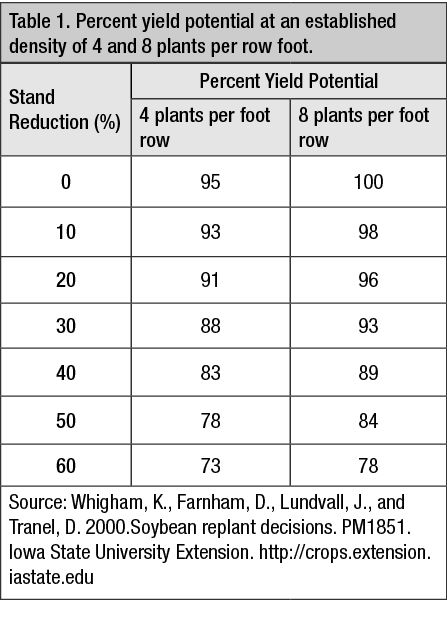5 MIN READ
Managing Flooded Soybean Fields
July 7, 2021
Saturated soils lack enough oxygen, which can inhibit root growth, leaf area expansion, and the photosynthetic process.
Soil crusting and seedling diseases are common problems to watch for after flooding.
It is important to scout fields entirely before making the decision to replant.
Saturated and Flooded Fields
Along with soil temperature, soil moisture and oxygen levels are important factors for seed germination and plant growth. When soils are saturated, such as in flooded or ponded soils, oxygen availability, and therefore plant growth, is decreased.1 Young plants may develop yellow leaves due to slowing of photosynthesis and plant growth. Lack of oxygen because of a prolonged period of saturated soil can reduce germination and emergence. In addition, portions of roots may die. However, there is still a chance for survival unless the growing point is damaged.
The longer an area remains saturated, the higher the risk of plant death, and higher air temperatures can shorten the number of days of survival. According to University of Minnesota Extension, typically for soybean, yield losses are not noted in fields flooded for two days or less. Four days or more of flooding can stress the crop, delay plant growth, and cause shorter plants with fewer nodes. Six days can cause significant yield loss, while flooding for a week or more can result in loss of the entire stand.2

Figure 1. Submerged soybean plants.
Soil Crusting
Soil crusting can occur when a crust layer forms on the soil surface as wet soils dry. The crust layer can delay or prevent seedling emergence. In addition, soybean hypocotyls can easily be broken when trying to push through the crust. Crusting may be more common in fields with fine textured soils, low organic matter, and little surface residue, especially where excessive tillage has taken place.3 A rotary hoe can break up the crust and aid seedling emergence. Timing is essential and breaking the crust as soon as possible is most beneficial.
Soybean Diseases
Saturated soils and flooded conditions promote a number of diseases in soybeans both immediately following flooding and later in the season. Wet conditions are favorable for several pathogens to sporulate, germinate, and infect plants.
Pythium - Wet conditions are favorable for Pythium and cooler soil temperatures will make this worse as the seedling will be stressed and grow more slowly. Typical symptoms of Pythium infection include seed decay, pre-emergent seedling rot, and post-emergence seedling damping-off. If the plant has emerged, it often may have a root system where the outer layer can be easily pulled off and the center of the root will stay intact.
Phytophthora - As soil conditions warm up, Phytophthora often becomes more common with heavy rains. Fields with a history of this disease can experience a flare up when rains saturate soil profiles. Typical symptoms of Phytophthora infection are seed decay and pre-emergence seedling rot, and post-emergence seedling damping-off. Typical symptoms on seedlings are darkened stems at the base of the plant coming up from the soil line. When young plants are cut at the lower stem, the vascular system may be dark and rotted. Phytophthora can kill plants at any stage of development, but Pythium typically does not kill plants much past the V5 growth stage.
Scouting and Replanting Options
It is important to scout fields within four to seven days after the water has receded. Soybean seedlings must have viable buds on the stem and should show signs of growth. Stand counts need to be taken to see if a desirable plant stand survived (Table 1). Count intact plants with buds or expanded leaves. Research across the Midwest shows that yield decreases by 2 to 6% for every 10% reduction in stand counts below 150,000 plants per acre for stand reduction that occurs two to four weeks after planting. Soybean plants usually compensate well and fill in small gaps by branching out. If there are numerous gaps larger than 2 feet in diameter, consider replanting as the plant can’t fill in these larger gaps.4
If replanting with soybeans, minimum or no tillage is recommended to maintain the efficacy of any herbicides and/or soil insecticides already applied to the field. Plant soybeans 1 to 1.75 inches deep and not deeper than 2 inches. Planting too deep can burn the energy that could be used later by the plant. In addition, planting too deep can inhibit emergence in stressful situations, such as soil crusting and compaction.

Sources:
1 Timmerman, A., Giesler, L., Elmore, R., and Williams, T. June 22, 2018. Flooding and ponding in soybean. Cropwatch. University of Nebraska-Lincoln. http://cropwatch.unl.edu.
2 Coulter, J., Naeve, S.L., Malvick, D., and Fernandez, F. 2018. Flooded soybean. University of Minnesota Extension, http://extension.umn.edu
3 Duiker, S.W. September 17, 2017. Soil crusting. Penn State Extension. http://extension.psu.edu.
4 Weibold, W. and Massey, R. November 2018. Corn and soybean replanting decisions. G4091. University of Missouri Extension. http://extension.missouri.edu.
4014_S3